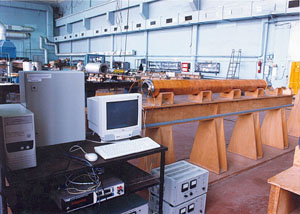
A new magnetic system for Fermilab’s Tevatron collider has been designed and built in a collaboration between Fermilab and the Institute for High-Energy Physics (IHEP) in Protvino, near Moscow. The Tevatron Electron Lens (TEL), to be installed in the proton-antiproton collider ring, produces a solenoidal field to focus an electron beam. This affects the antiproton beam, compensating beam-beam effects.
The TEL magnetic system was fabricated at IHEP, and tested at Fermilab last autumn. It consists of seven superconducting magnets (a solenoid and six steering dipoles) and two conventional solenoid magnets equipped with correction coils.
The electron beam from an electron gun cathode is transported through the interaction region in a strong field of the superconducting solenoid and absorbed in the collector. The main TEL element is the superconducting solenoid, which is 2.5 m long with a 6.5 T field. The solenoid coil (inner radius 76 mm) is made of flat transposed cable consisting of 10 wires (niobium-titanium filaments in a copper matrix), each 0.85 mm in diameter.
With 7289 superconducting coil turns the inductance was 0.6 H (operating current 1.8 kA, stored energy 950 kJ). Studies of the quench processes have shown that the coil is not self-protected against resistive transition and some protective precautions, namely fast quench detection and removal of stored energy to the external dump resistor, must be taken.
In the first high-current test of the superconducting solenoid, 5.64 T was reached at the current ramp rate of 3 A/s. The second quench took place at 6.6 T at 3 A/s, and after that the solenoid could not be quenched up to 6.7 T at 10, 20 and 30 A/s (the maximum allowed by the power supply). The magnet quenches very quietly and does not consume much helium at the quench.
Two field-measuring systems record the magnetic field distributions. The first uses a Hall probe in three dimensions, which records the field in every direction for each position. The second tracks field lines by a magnetic rod. A small trolley holds a freely rotating magnetic rod with a mirror. This trolley is moved inside the solenoid, and small deviations in the local field move the mirror and reflect the laser beam.
Six steering superconducting dipoles are placed on the outer surface of the superconducting solenoid coil. All are for correction of the electron-beam trajectory inside the magnetic system. The superconducting solenoid and the steering dipoles are enclosed in a yoke of low carbon steel. This improves the magnetic-field homogeneity inside the solenoid aperture. All superconducting coils together with the steel yoke are enclosed in a helium vessel. The TEL cryostat is part of the Tevatron magnet string cooling system.
Further reading
Following the shipment of a venerable electron machine from the Dutch NIKHEF laboratory to the Joint Institute for Nuclear Research (JINR), Dubna, near Moscow (see In retrospect: electron scattering in Amsterdam;February 1999), the DELSY Dubna Electron Synchrotron project has been proposed by NIKHEF, JINR and the Budker Institute, Novosibirsk. DELSY would be a third-generation synchrotron radiation source, allowing a broad spectrum of research in the areas of physics, chemistry, biology and medicine.





